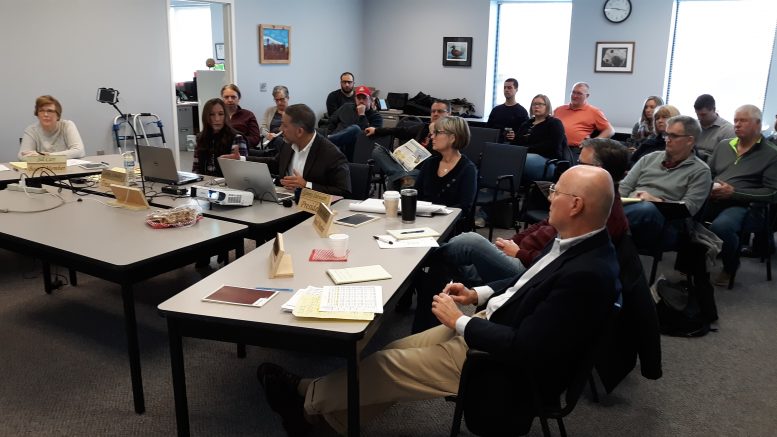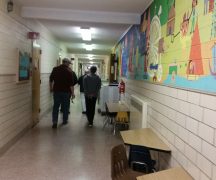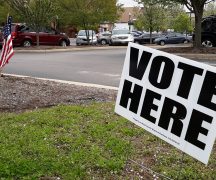By JAN LARSON McLAUGHLIN
BG Independent News
Remember story problems? Three old trains are barreling toward Bowling Green, while two new trains are headed toward the same location at the same time.
Only this story problem doesn’t ask which train will arrive first at the station. The question behind this story problem is – which trains will voters get on board and support at the polls.
Bowling Green Board of Education spent another long Saturday work session going over its options for dealing with a potential five tax issues going before voters in the next two to four years.
It appears the board may be narrowing its options to possibly putting two renewal levies on the ballot this fall.
David Conley, the district’s financial consultant from Rockmill Financial, used the train analogy so the board could visualize the three existing tax issues coming due in the district. One option, he said was merging two of the trains onto one track – or in this case, combining two tax levies into one issue.
While the plan to reduce tax requests on voters was attractive, some board members were clearly leaning toward biting the bullet and asking instead that voters to approve two existing levies for a continuing period of time.
Where does BG stand right now …
Here’s a refresher on the levies coming due for the school district:
- 4.2-mill current expense levy, generating about $2.4 million a year, which expires in 2020.
- 1.6-mill emergency levy, generating about $1 million a year, which also expires in 2020.
- 0.5 percent income tax, generating about $3.2 million a year, expiring in 2022.
Those add up to $6.8 million a year. Failure to renew those would hit the district hard, Conley said.
At the same time, Bowling Green needs new money (those are the new trains barreling toward the station). Those options include:
- New operating levy, with an undetermined source of income or property tax revenue.
- Funding for new facilities, which Conley estimated will be anywhere from $30 million to $50 million. Again, the source of these funds may be income tax, property tax, or combination of the two.
To figure out the story problem, Conley said the board must identify its priorities.
“Your priorities will help us figure out where you go from here,” he said.
The board identified the following priorities for the district:
- Preserve the existing rollback, which benefits local taxpayers.
- Try for levy renewals – but turning them into continuing levies, rather than sticking with the five-year terms.
- Don’t wait till the last minute to try renewing the levies that expire at the end of 2020 – possibly going on the ballot this fall.
- Make more income tax a part of future school funding. Whether that is traditional or earned income tax is yet unknown.
- Identify sources of new money that will be needed by the district for operations.
Board member Paul Walker also expressed his feelings that the board needs to look at cutting costs as it looks at new funding.
Why rescuing rollbacks is so important …
The board seemed in agreement that keeping the rollback benefits for taxpayers is important. In 2013, the state decided to stop paying 12.5 percent of school levies – leaving the entire bill for taxpayers to foot.
The state will continue paying that percentage on any levy amounts approved prior to 2013. So if the millage is kept the same, and voters approve a renewal, they will still benefit from the rollback.
“It seems like we should take that into consideration,” Geer said.
So while it may be appealing to just put one levy on the ballot, if the emergency and current expense levies were to be combined, the rollback on the smaller levy would be lost. While that amount would be small ($7 a year for a home valued at $100,000), the board seems to be committed to being able to say the levy issues will result in “no new taxes.”
So instead of combining the two levies, board members Norm Geer and Paul Walker stressed the value of passing them individually – but as continuing rather than ending after five years.
“We could fight that battle one time,” Walker said.
That would allow the district to budget more effectively, if the board didn’t have to worry about the levies ending, Geer said.
“It takes a major portion of your worries,” Conley said.
And the voters would still maintain their 12.5 percent rollbacks.
History of strong voter support …
Conley said that in his experience, continuing levies are successful with voters if the districts communicate the need and the savings. Voters in some districts believe they retain more control by not passing continuing tax issues.
“The taxpayers want to keep school districts honest,” he said.
However, the likelihood of the district not needing that renewal money, and the costs to keep going back on the ballot should be considered, Conley added.
“There’s a cost associated every time you go on the ballot,” he said.
Superintendent Francis Scruci expressed concern about voter fatigue, and board members asked about the chances of voters passing two levy renewals, turned into continuing issues.
“The message has got to be there,” Board President Ginny Stewart said about the “no new taxes.”
Conley pulled up the district’s history on the ballot, showing 100 percent support for tax renewals.
“The voters are really supportive,” he said.
The idea of not having to keep asking for the same money sounded good to many on the board.
“If we just renew it for five years, we’re going to be talking about it again in five years,” Scruci said.
Conley also pointed out that besides the building issues that were rejected recently, the district has not asked voters for an increase in funding since 2010.
“You don’t last nine or 10 years unless you are doing a good job with expenses,” Conley said. Most districts need to seek additional funding every three to five years, he said.
“You have been spending your money wisely,” he said.
BG needs a big general fund balance …
Conley also addressed the issue of the district’s general fund balance – which has been criticized by some citizens asking why the district sought so much for buildings, when the balance sits at about $15 million.
That large of a general fund balance is necessary, Conley explained.
“People will say that’s a lot of money,” he said. But the state requires that type of balance. If the district failed to renew a levy, or a recession hits, that balance could quickly be wiped out.
“You guys would be toast,” Conley said. “You would start to hemorrhage pretty significantly. If you want to be financially smart, you not only need to pay your expenses, you need a reserve.”
And if programs had to be cut, student numbers would follow.
“If we cut a lot of things, then we’ll lose enrollment,” Scruci said.
However, the district could survive on a smaller balance if it changed to a less risky tax structure – and passing continuing levies is one way to do that. The other way is to not rely heavily on income taxes, which are more susceptible to recessions.
Uncertainty about the state siphoning more away …
Bowling Green doesn’t rely on as much funding from the state as many districts – getting about $8.5 million a year.
“The state does not see you as under-privileged,” Conley said.
For that reason, the state could actually siphon off some of the tax revenue Bowling Green is expecting to get from the Rover pipeline that runs through the district.
“We may or may not get this money,” since the state may think another district needs it more, Conley said. “You kind of have to hold your breath.”
Scruci talked about unfunded mandates by the state, such as the College Credit classes which the district must purchase textbooks for each year.
“Those are things out of our control that are draining our income,” he said.
Scruci also pointed out the harm to districts caused by former Gov. John Kasich’s cut of business inventory and equipment taxes.
“We don’t know when the next ax is going to hit,” he said.
And now, with former State Senator Randy Gardner being promoted to the state’s chancellor of higher education, public schools no longer have him as a strong advocate in the statehouse, Scruci said.
Building and future funding issues loom …
Passing the existing three tax issues will definitely help, but the school district needs more if it’s going to give pay raises, build or renovate schools and then have money to operate those.
The board is waiting for its citizen task forces to wrap up their recommendations about school facilities. The future of the school buildings will make a big difference in the district’s future, Conley said.
“I can tell you as sure as I’m sitting here – facilities matter,” he said. “The curb appeal really matters.”
For the sake of looking at taxing possibilities, Conley played around with some ways to raise $50 million for new or renovated buildings. He calculated the amount of funding needed per household for various options:
- $662 a year from the average household if an earned income tax was used.
- $331 a year from an average household if a traditional income tax was used.
- $221 a year for the owner of a $161,300 home if a property tax was used.
The property tax would cost the average home so much less because businesses pay property taxes, but not income taxes. In Bowling Green’s district, businesses pay about one-third of the property tax revenue raised.
“But just because it’s lower doesn’t mean it’s right for this community,” Conley said.
Studying school income tax options …
The school board has talked about the need to rely on both income and property taxes.
Unlike property taxes, income taxes are only paid by residents. Conley and the board spent a great deal of time talking about the differences between traditional and earned income taxes. School districts are only allowed to have one or the other – but not both types of income taxes.
Traditional income tax is collected on all residents’ incomes. Earned income tax, however, is not collected from those 65 and older, on capital gains, on LLCs, or on those without incomes.
Earned income tax is collected from fewer people – so higher amounts have to be collected from those impacted.
“You could have wealthy people not being taxed,” Stewart said. Conley agreed.
Stewart questioned if an earned income tax would work well with Bowling Green’s demographic of so many older residents in the community. Conley agreed that could be a concern.
Geer questioned why Bowling Green has one of the lower income taxes in place in the state. But Conley said only about 100 of 600 districts collect any income tax.
“The vast majority of school districts don’t have an income tax,” Conley said.
Currently, Northwood collects 0.25 percent in income tax. Bowling Green has 0.5 percent, the same as Perrysburg. Eastwood and Otsego collect 1 percent, and Elmwood and North Baltimore collect 1.25 percent.
While income tax provides some relief from those paying property taxes, they are riskier for school districts, Conley said.
Property taxes can withstand recessions well, but income taxes do not. The district saw a 12 percent drop in collections during the last recession, he said.
Where does the board go from here …
The school board will meet again next Saturday at 9 a.m., in the district administrative offices, for another work session. The public may attend, but no input will be allowed.
“You have homework to do,” Conley told the board at the end of this weekend’s meeting. “I think we’re making some progress though.”





